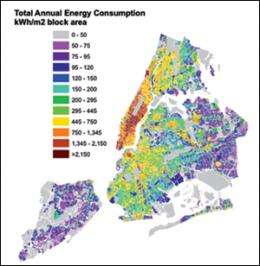Pay-as-you-go approach to powering the world

(PhysOrg.com) -- Vijay Modi, a professor of mechanical engineering, is working to create sustainable energy models for cities, such as New York, where current infrastructure will not be able to support future demand, and for countries as far away as Tanzania, where power costs are high and energy is inefficient.
Modi and Bianca Howard, a Ph.D. student in mechanical engineering, along with collaborators from the School of International and Public Affairs, the Earth Institute and the Mayor’s Office, have undertaken a building energy mapping project in New York City. Buildings in New York City used a total of 248,487 gigawat hours of energy in 2009. Although this energy comes from a variety of sources, if it were all from oil, it would be equivalent to 7 gallons of oil per person per day.
“The current energy distribution infrastructure in many urban areas either cannot support anticipated future energy use or would require significant rehabilitation even if current use were maintained,” Modi and Howard wrote in a paper explaining the study. They used a mathematical model based on statistics, not private information from utilities, to estimate the annual energy consumption values of buildings throughout the five boroughs and were able to break down what type of energy is being used, for which purpose and in what quantity.
Modi hopes that an understanding of urban energy demand patterns can spur measures to curb power usage, update and enhance infrastructure and introduce alternative energy sources. They also plan to make their database available to the public.
“Information is the first step toward sustainability,” Modi said.
Modi also focuses his attention thousands of miles from New York, by creating Shared Solar, a Columbia University/University of California, Berkeley research group that aims to “reach people at the bottom of the pyramid,” he said. He has devoted much time to understanding the energy needs of the poor in Africa and India. “They want flexibility, they want the ability to purchase electricity in small quantities just when they need it, and pay for in small amounts.”
For the last five years, Modi’s work in this realm has centered on “Millennium Villages” in Africa, where the Earth Institute is carrying out public health, education, and environmental initiatives based on United Nations Millennium Project recommendations. In 2002 a U.N. advisory board, led by Earth Institute Director Jeffrey Sachs, developed an action plan for ending extreme poverty in the world. Environmental sustainability was one of its eight major goals.
“Research throughout the Millennium Villages has shown that the rural poor are paying as much as $5 per month for kerosene, batteries and other energy inputs that could be more efficiently and cheaply supplied by electricity from a centralized source,” Modi wrote in a Shared Solar research paper. Several obvious solutions, such as expanding electricity grids and installing in-home solar units, are too cost prohibitive, he added.
“The unfortunate irony is that the poorest are paying the most per unit of useful energy and for the poorest quality of service. Unfortunately the high cost of running wire from central power plants and connecting them to a grid does not present an appealing, profitable business model,” Modi wrote.
His solution, already instituted in more than 2,000 households and businesses in Mali, Uganda and Tanzania, involves shared micro-grids with prepaid metering. Participants can purchase the equivalent of a prepaid calling card and text the card’s number to a server, which credits the customer’s account. The grid’s meters control the output of solar-generated electricity based on the customer’s usage and remaining credit. The model has low upfront costs and allows customers to pay only for what is being delivered, Modi said.
It was first launched last year in Palengana, Mali, where users have reported that lighting, once powered by batteries and kerosene, has significantly improved. “Shopkeepers, tailors and barbers are happy because they can stay open later,” Modi said. Education is also benefiting—one school hooked up to a shared micro-grid, and Modi has heard reports that students in the village stay up later to study.
Provided by Columbia University



















